Meet the Maker: Kristin Evensen
This Orangeville artist strings together her Anishnaabe heritage and contemporary design in every pair of earrings she makes.
Kristin Evensen vividly recalls watching her grandmother, surrounded by canisters of brightly coloured beads, as her flying fingers nimbly decorated handcrafted moccasins. Her grandmother’s quilts, dreamcatchers, medicine bags and birch bark art are other early memories.
“I’ve always been an artist,” says Kristin. “My life has been surrounded by art and design, as well as by my Indigenous heritage.”
Born in Toronto, Kristin moved with her family to Christian Island, part of Beausoleil First Nation, when she was three, then to Orangeville at age nine. After living in Toronto for a few years, she and her husband bought a house in Orangeville where they now live with their three young children.
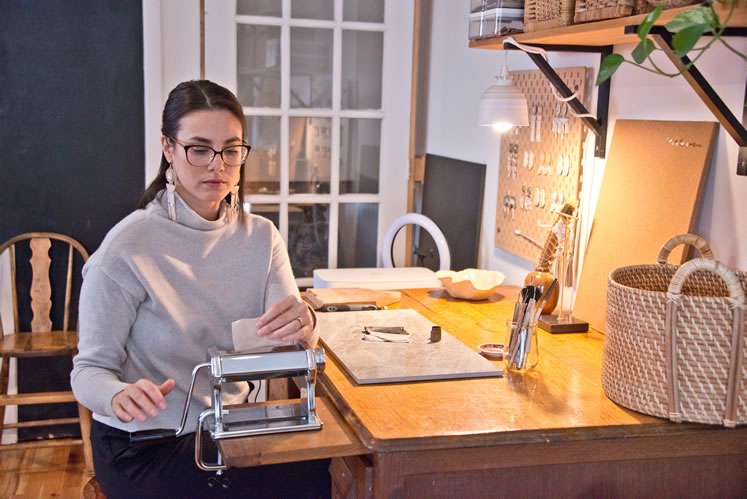
Jewelry maker Kristin Evensen at work in her Orangeville studio. Photo by Pete Paterson.
Kristin studied design at George Brown College where she experimented with a variety of media. Her first foray into her own design business involved knitting patterns, but when she started beading two years ago on a journey to deepen her connection with her Anishnaabe heritage, she found her primary medium. She watched YouTube tutorials on traditional beadwork practices and began to create her own designs. Six months later she launched her Etsy shop, K. Frances Beadwork, which specializes in earrings. Though her technique is influenced by cultural traditions, her aesthetic is exuberantly contemporary.
Kristin’s process begins with a colour palette influenced by nature, fashion and favourite works of art. For this year’s spring collection, for example, she envisioned soft, light hues inspired by natural stone.
Kristin uses polymer clay – laced with a subtle metallic shimmer to add depth and light-catching visual texture – to fashion central cabochons, the unfaceted, polished “gemstones” that anchor her earrings. She bakes the cabochon at 275F (135C) and sands it with wet, fine-grained automotive sandpaper before polishing it with a Dremel tool. The cabochon is then fixed to a felt backing that also serves as the backing for the glass seed beads she stitches into place around the polished stone. She then glues all this to a sustainably sourced deer-hide backing.
Kristin has found an online Indigenous merchant who sells scrap bags of deer hide left over from other artists’ larger projects, as well as smaller pieces of hide purchased from hunters who can’t use it all. Maintaining this continuum with traditional practices and materials is just one way she is building a business that is both authentic and highly contemporary.
The drops for each earring are also formed from polymer clay, processed in much the same way as the cabochon. Kristin uses shape cutters and homemade stencils to create the shapes. “Indigenous cultures are particularly genius at using shape and colour to communicate through art,” she says. As an example, she cites acclaimed Michif (Métis) artist Christi Belcourt, whose paintings resemble traditional beadwork and depict Indigenous traditions and their interplay with the natural world.
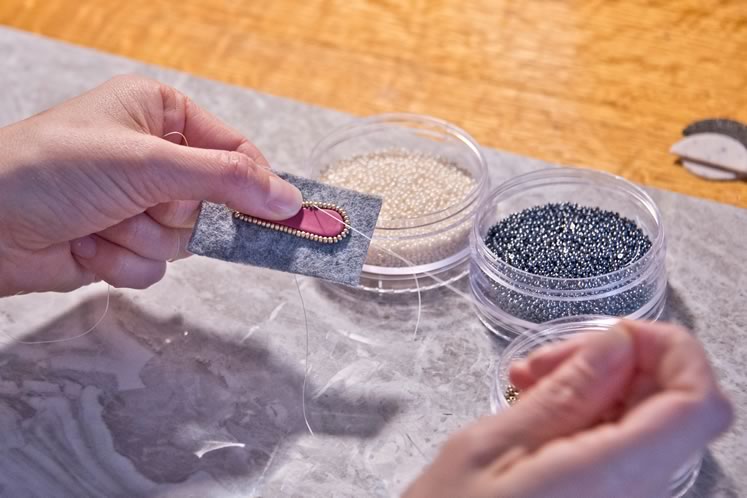
Kristin adds beadwork to an earring. Photo by Pete Paterson.
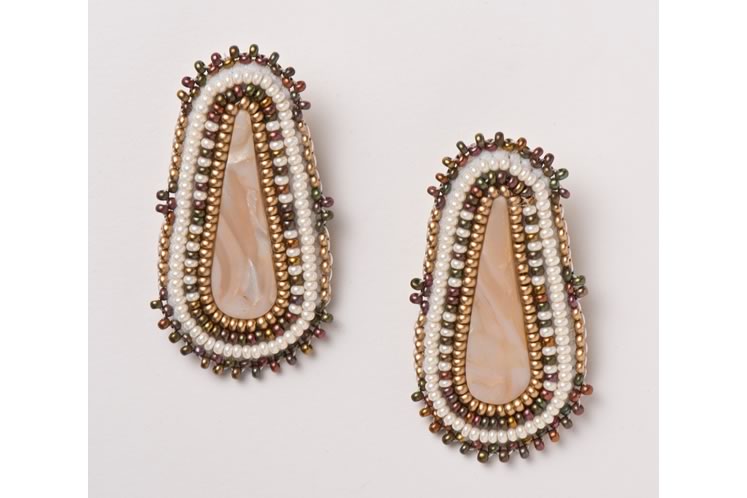
A pair of polymer clay, bead and deerskin earrings. Photo by Pete Paterson.
“I use my culture’s language and teachings as a way to guide my business practices and build relationships with my customers and other artists,” she says, adding that she uses an Anishnaabemowin (the language of the Anishnaabe) word or phrase to name each new earring design. “It helps me to reclaim and learn my language, teach and inspire others, and hopefully bring some awareness, understanding and appreciation of Indigenous culture.”
Her Animikii (thunderbird) earring design, for instance, with its circular cabochon and beads that resemble the sun, was inspired by Anishnaabe stories that tell of the thunderbird flying close to the sun to deliver messages to the Creator. The names Kristin chooses, however, aren’t always a literal representation of the shapes. Some, such as Nibwaakaa (meaning she or he is intelligent or wise), represent the feeling she draws from the design as she works on it.
In addition to operating her Etsy shop, Kristin sells at local shows and events, including the Museum of Dufferin’s Holiday Treasures show and at Dufferin County’s celebration of National Indigenous Peoples Day.
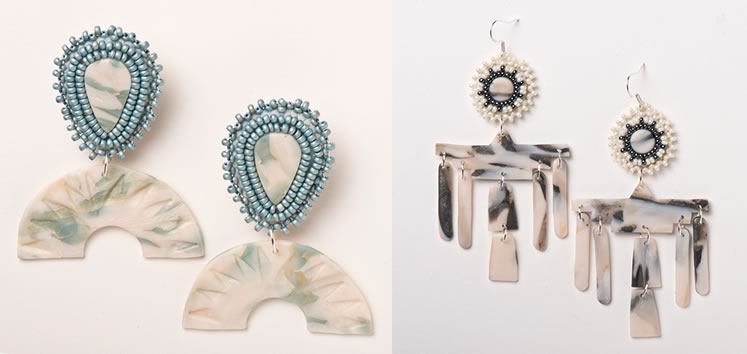
Original designs by jewelry maker Kristin Evensen. Photo by Pete Paterson.
She notes that, for traditional ceremonies, Indigenous people wear regalia, including colourful jewelry that reflects the individual. Because her designs are not intended to be worn as regalia, her view is that it’s fine for non-Indigenous folks to wear her creations.
“My earrings are for everyone,” she says. “Buying from an Indigenous maker shows cultural appreciation. Personally, I want to share our designs and stories with the world, and I’m proud and happy when someone supports my work.”
Related Stories
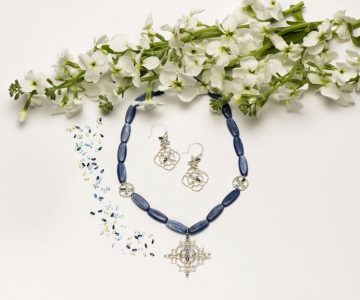
Meet the Maker: Anne-Marie Warburton of Gallery Gemma
Jun 25, 2020 | | Made in the HillsThis jeweller crafts her designs to match the individual – even when meeting them in person was on hold.
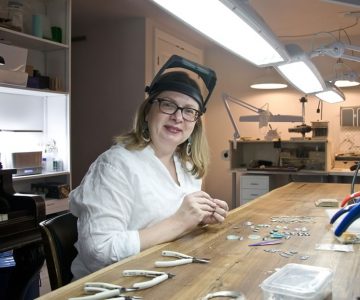
Meet the Maker: Heidi von der Gathen
Jun 20, 2019 | | Made in the HillsAn Orangeville jeweller casts nature as the star of her striking one-of-a-kind pieces.
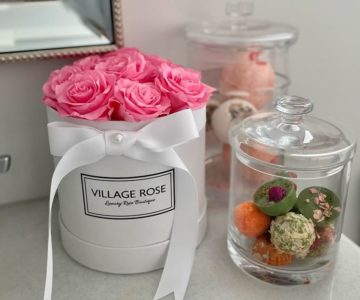
Local Buys: Spring 2021
Mar 31, 2021 | | Made in the HillsFixate on florals this spring – fresh, preserved and, yes, paper.
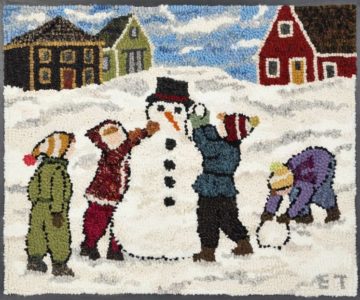
Local Buys: Winter 2020
Nov 24, 2020 | | Made in the HillsWhat we’re shopping for this winter in Headwaters.
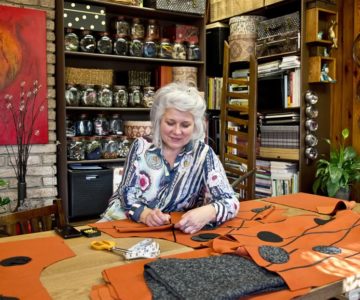
Meet the Maker: Cristina Repanovici
Nov 24, 2020 | | Made in the HillsHow a designer found her groove in Caledon East by offering one-of-a-kind jewelry pieces and sculptural clothing creations.
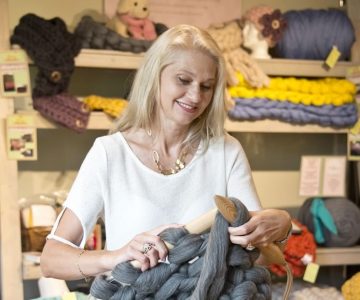
Meet the Maker: Svetlana Ponkin
Sep 18, 2020 | | ArtsFrom the Alton Mill to the One of a Kind Show, this knitter’s up-sized pieces are wowing collectors.








